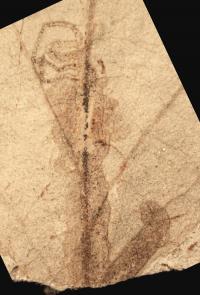
A leaf mine on an unidentified leaf from the PETM. Insects will feast and leafy plants will suffer if temperatures warm and atmospheric carbon dioxide increases, according to a team of researchers who studied evidence of insect feeding on fossil leaves from before, during and after the Paleocene-Eocene Thermal Maximum.
The PETM occurred 55.8 million years ago and was an abrupt global warming event linked to a temporary increase in carbon dioxide in the atmosphere. This event is comparable in size and rate to the current climate changes brought on by human activity.
"Our study suggests that increased insect herbivory is likely to be a net, long-term effect of anthropogenic carbon dioxide increase and warming temperature," the researchers report today (Feb.11) in the online Proceedings of the National Academy of Sciences.
Today, the tropics have the most diverse insect populations and the highest rate of herbivore damage on leaves. This implies that there is a correlation between insect feeding and temperature. The researchers, who include Ellen D. Currano, graduate student in geoscience, and Peter Wilf, associate professor of geoscience, Penn State; Scott L. Wing and Conrad C. Labandeira, Department of Paleobiology, Smithsonian Institution; Elizabeth C. Lovelock, graduate student in earth science, University of California, Santa Barbara; and Dana L. Royer, assistant professor, earth and environmental sciences, Wesleyan University, looked at fossil leaves from the Bighorn Basin in north central Wyoming from layers deposited in the late Paleocene, in the middle of the PETM and in the early Eocene.
"We looked at these time periods to see evidence of insect feeding and to count the types of damage," says Currano. "We looked to see how much damage the insects did and the kinds of leaves on which the damage occurred."
They identified 50 types of damage on the fossil leaves including holes of varying sizes, chewed-out areas, galls and mines.
"We can identify certain insect groups by the way they feed on a leaf," says Currano. "Some make mines while others chew along the edge of the leaf."
By looking at modern insect's behavior, the researchers can determine the types of insects eating the fossil leaves. They compare modern leaf damage to that occurring in the past.
The team found that the percent of leaves damaged by insects was 15 to 38 percent during the Paleocene and 33 percent during the Eocene, but increased to 57 percent during the intermediate PETM. This large increase in insect herbivory corresponded to a time of increased carbon dioxide and temperatures. The researchers also found that the increased feeding occurred in all plant species and that a more diverse array of insects fed on the leaves.
The researchers investigated the leaves that grew during the PETM to ensure that the leaves growing then were not tougher and less tasty than those found before or after that period. They found no differences between the heavily eaten leaves and those from time periods with less herbivory.
"With more carbon dioxide available to plants, photosynthesis is easier and plants can make the same amount of food for themselves without having to put so much protein in their leaves," says Currano.
Consequently, when carbon dioxide increases, leaves have less protein and insects need to eat more to acquire the nutrients they need. While increased carbon dioxide is good for the plants in that they can increase growth, plants also suffer from increased feeding by insects.
The researchers explain that the increase in insect feeding is a result of the tripling of carbon dioxide in the atmosphere during the PETM and the accompanying rise in temperature. They think that increases in temperature and carbon dioxide levels during the PETM are good analogs for the future and therefore, that plants may eventually experience higher rates of feeding as humans put more carbon dioxide into the atmosphere.
Source : Penn State
 Print Article
Print Article Mail to a Friend
Mail to a Friend
